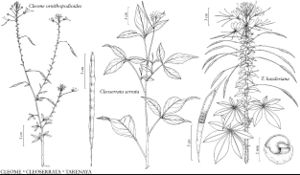Tarenaya
Sylva Tellur., 111. 1838.
| Taxon | Illustrator ⠉ | |
|---|---|---|
 | Cleome ornithopodioides Cleoserrata serrata Tarenaya hassleriana | Yevonn Wilson-Ramsey Yevonn Wilson-Ramsey Yevonn Wilson-Ramsey |
Herbs [shrubs], annual. Stems sparsely to profusely branched; glabrous or glandular-pubescent (sometimes spiny). Leaves: stipular spines present [absent]; petiole with pulvinus basally or distally, (petiolule base adnate, forming pulvinar disc; spines present); leaflets [1 or] (3) 5 or 7 [–11] (with tiny prickles terminating teeth). Inflorescences terminal or axillary (from distal leaves), racemes (flat-topped or elongated); bracts present [absent]. Flowers (often appearing unisexual due to incomplete development), zygomorphic; sepals persistent, distinct, equal (each often subtending a nectary); petals equal; stamens 6; filaments inserted on a discoid or conical androgynophore, glabrous; anthers (linear), coiling as pollen released; gynophore recurved in fruit. Fruits capsules, dehiscent, oblong. Seeds 10–30+, triangular to subglobose, not arillate, (cleft fused between ends). x = 10.
Distribution
Introduced; South America, worldwide in tropical and warm-temperate regions
Discussion
Species 33 (2 in the flora).
Traditionally included in a broad circumscription of Cleome, Tarenaya is distinguished by its stipular and petiolar spines, absence of arils, and seeds with a large cleft cavity. All species are native to tropical America, with the exception of T. afrospina (H. H. Iltis) H. H. Iltis, of western Africa. Tarenaya hassleriana, long known as C. spinosa (and commonly by the misapplied name C. houtteana) and more recently as C. hassleriana, is a popular garden ornamental and, probably, the most widely distributed member of the family.
Selected References
None.
Lower Taxa
Key
| 1 | Sepals, ovary, and capsules glabrous; petals usually pink or purple, sometimes white. | Tarenaya hassleriana |
| 1 | Sepals, ovary, and capsules ± glandular-pubescent; petals white or greenish white. | Tarenaya spinosa |